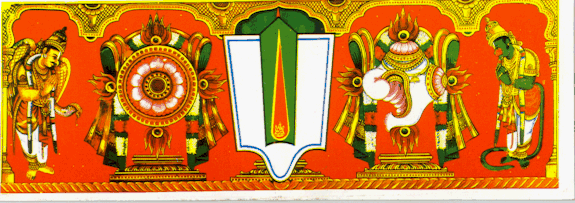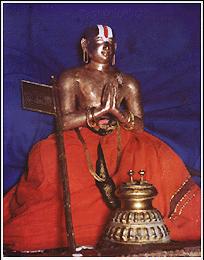
Sri Ramanuja Acharya

Sri Ramanuja is known as the greatest exponent of Visishtaadvaita Vedanta. He appeared around 1017 A.D in a pious Brahmana family. He became the foremost Acarya in the Sri Sampradaya and was reputed to be the incarnation of Sri Lakshmana, the younger brother of Lord Sri Rama.
Sri Ramanuja was born and brought up as a Tamil Vaishnava (worshipper of Vishnu) steeped in the tradition of the twelve great Alvars (Tamil Vaishnava devotional poets, including Andal, a female saint) and their 4,000 verse devotional hymns known as Divya Prabhandham, also revered as Dravida-Veda (Southern Vedas).
Ramanuja was a boy of extraordinary intelligence and placed himself under the charge of Yadavacharya, a renowned Sankarite scholar. Ramanuja’s guru was struck by the boy’s marvellous intellect and became very uncomfortable on account of his firm faith, or bhakti. One day while taking a massage, Yadavacharya was explaining to Ramanuja a sutra “tasya yatha kapyasam pundarikamevamaksini”(Chandogya Upanishad 1.6.7), saying that according to Sri Sankara, the two eyes of Pundarika are like two lotuses which are red like the nates of a monkey. On hearing this interpretation with the unbecoming and low simile, Ramanuja’s soft heart, tender by nature and softened by devotion, melted and as he was massaging, tears rolled down from the corners of his eyes like flames of fire and fell on the thigh of Yadava. Looking up at the touch of the hot tears, Yadava understood that something troubled his disciple. Ramanuja explained his dismay at hearing such an unbecoming explanation from his guru. He thought it sinful to compare with the posterior of a monkey the eyes of the Supreme Personality of Godhead – who is endowed with all gracious qualities and who is the repository of all the beauty of the universe. Yadava was angry at the boy’s audacity and told him to explain the verse if he could. Ramanuja analyzed the word “kapyasam” to mean `blossomed by the sun’ and the verse to mean “The eyes of that Golden Purusha are as lovely as lotuses blossomed by the rays of the sun.”
After a few such incidents when Ramanuja corrected his guru, Yadavacharya thought him to be a threat to the Sankarite line and plotted to kill him. Later it came to pass that Yadavacharya was to become the disciple of Sri Ramanuja.
Sri Ramanuja Acharya’s Visishtadvaita school of Vedanta made profound influence in Hindu thought and practice, since his teachings included devotional bakthi ideas in his interpretations of Vedanta that reflects the religious perspectives of most Hindus throughout India.
The seeds of Ramanuja’s development of Visishtadvaita school of Vedanta began early in his life, when he was a disciple of a strict Advaita Vedanta teacher, Yadava-Prakasa. The teacher interpreted the Upanishad passage, ‘sathyam jnanam anantham brahma’, as meaning, ‘Brahman is Truth, is Knowledge, and is Infinity.’ Ramanuja objected to it and said that the passage means that Brahman is endowed with the qualities of truth, knowledge and infinitude. These qualities are His, but not He, just as ‘my body is mine, I’m not the body.’
On another occasion, Yadava-Prakasa was discoursing on the Upanishad passage — ‘sarvam khalvidam brahma, neha nanasti kinchana‘ ‘All this is verily Brahman; there is no diversity here whatever.’ [Chandogya Up. 3.14.1] With great eloquence Yadava taught that it meant that the atman and Brahman are identical. Ramanuja told Yadava that in his view the passage would have meant the oneness of all with Brahman, if it were not followed by —tajjalan iti, shanta upasita — “This universe is born from, sustained by, and dissolves in Brahman; meditate thus on Him.” This qualification makes the earlier part meaning that ‘The things in this Samsara (worldly life) have no independent existence; they are inter-penetrated by Brahman and held as a unity without impairing their manifoldness.” Just as a fish in water is said to be born in water, exists in water and dies in water, and may be said to be permeated by water but it never can become water! In this manner the universe is said to be permeated by Brahman but can never become Brahman! This interpretation of a qualified non-dualist nature of atman and Brahman got him expelled by his teacher.
In a break with social tradition, Ramanuja, a Brahmin by birth and education, became a disciple of Kanchi-purna, a lower caste (sudra) great devotee of Lord Vishnu. Ramanuja also pursued the study of the Tamil hymns of the Alvars, who are from all strands of society. Ramanuja justified his act claiming that Kanchi-purna’s mature devotion to the Lord was far superior to high birth and learning. Ramanuja revealed the sacred manta, Om Namo Narayana, to all persons, regardless of social status or gender. These actions illustrate Ramanuja’s emphasis on devotional aspirations.
Yamunacharya the foremost exponant of Vaishnava philosophy of the time, knowing of his extraordinary ability and purity, called for Sri Ramanuja with the intent of placing him in charge of the mission after his disappearance. Ramanuja was on his way to see Yamunacharya when he received the news of Yamunacharya’s departure from the world. Arriving at Srirangam, Ramanuja went to have his last darshan of that great soul. There he noticed three of Yamunacarya’s fingers on his hand were closed.
Ramanuja then made three vows:He would make the people surrender to God and initiate them by the panchasamskara.He would write a commentary on the Vedantasutra which was later called Sri Bhashya.He would also write what is like an encyclopedia on the Puranas, and would name one greatly learned Vaishnava after Parasara Muni who wrote the gem among the Puranas, the Vishnu Purana.
Later Sri Ramanuja took sanyasa and travelled throughout India, vigorously defeating atheists and impersonalists by preaching the Visishtadvaita doctrine. He never failed to win over a rival in a spiritual disputation.
Sri Ramanuja’s Teachings:
His philosophy is Visistadvaita. Brahman is Narayana – (cit-acit-isvara), Narayana with Laksmi – (transcendental form), Four Vyuha forms, Vibhava forms. The qualities of Brahman are both nirguna and saguna. Brahman is omnipresent and eternal. The soul is real, eternal, individual, not omnipresent, not independent of Isvara but part. Isvara is the efficient cause of creation. It is from His will out of delight. The cause of bondage is beginningless karma. The process of release is through Bhakti, based on Pancharatra and Vishnu purana followed by detached karma that brings jnana – Prapatti. The goal is to attain the same nature of Isvara and companionship with Him.
The essence of his teachings are best summarized by his own prayer at the beginning of his Sri Bhasya:
“May knowledge transformed into intense love directed to Sriman Narayana (Maha Vishnu), the highest Brahman, become mine, the Being to whom the creation, preservation and dissolution of the Universe is mere play, whose main resolve is to offer protection to all those who approach Him in all humility and sincerity, and Who shines out like the beacon light out of the pages of the Scripture (Vedas)”.
According to Ramanuja, devotion to Deity Narayana (Lord Vishnu) is the true path to moksha, for devotion to the personal deity invokes the grace of God. The correct way is to seek refuge under the Lord’s feet (saranagati) through prapatti, pleading Him to grant moksha as a gift of His grace. Ramanuja refers to this transfer of burden to God as Bhara-samarpana.
For Ramanuja, bhakthi (intense devotion), and surrender to God is the primary means of attaining liberation (moksha) through the grace bestowed by the Deity Narayana who delivers them from the world. Ramanuja’s views on bhakthi and moksha are supported by verses such as 12.6-7 of the Bhagavad-Gita which states that “those who dedicate all their actions to Me, regarding Me as the Supreme goal, worshiping Me and meditating on Me with exclusive devotion, O Partha, I swiftly deliver them from the ocean of birth and death, for their consciousness is united with Me”.
Ramanuja masterfully combined the three strands of Vaishnavism: the devotional love of the twelve Tamil Alvar saints; the ritualism of the ancient Tantric Pancharatra Agama and the Vedanta philosophy exegesis. It is through devotion (bakthi) and self-surrender (prapatti) one can easily access the Ishvara (Lord Vishnu) for gaining His mercy and grace to attain moksha. Attaining moksha does not imply any merging with the existence of God but rather an ascent to the realm of Lord Vishnu where one remains eternally as His devotee. Ramanuja went to the extent of defining moksha as nothing but the privilege of service to God (nitya kainkarya praptireva moksha).
Indeed, Ramanuja’s Visishtadvaita is the philosophical fountain-head for most forms of devotional Hinduism and established Ramanujacharya as one of the great devotional theologians in world religions.